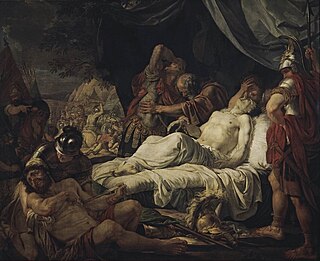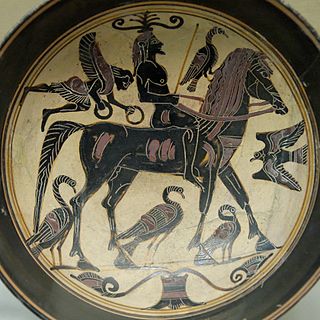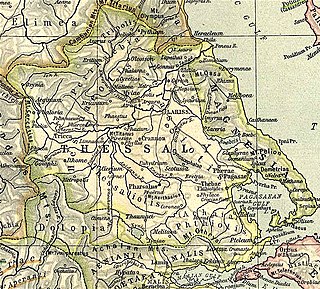Alexander was Tyrant or Despot of Pherae in Thessaly, ruling from 369 to c. 356 BC. Following the assassination of Jason, the tyrant of Pherae and Tagus of Thessaly, in 370 BC, his brother Polyphron ruled for a year, but he was then poisoned by Alexander who assumed power himself. Alexander governed tyrannically and was constantly seeking to control Thessaly and the kingdom of Macedonia. He also engaged in piratical raids on Attica. Alexander was murdered by Tisiphonus, Lycophron and Peitholaus, the brothers of his wife, Thebe, as it was said that she lived in fear of her husband and hated Alexander's cruel and brutal character.
This article concerns the period 379 BC – 370 BC.
This article concerns the period 369 BC – 360 BC

Thebes is a city in Boeotia, Central Greece, and is one of the oldest continuously inhabited cities in the world. It is the largest city in Boeotia and a major center for the area along with Livadeia and Tanagra.
Year 364 BC was a year of the pre-Julian Roman calendar. At the time, it was known as the Year of the Consulship of Peticus and Calvus. The denomination 364 BC for this year has been used since the early medieval period, when the Anno Domini calendar era became the prevalent method in Europe for naming years.

Epaminondas was a Greek general and statesman of the 4th century BC who transformed the Ancient Greek city-state of Thebes, leading it out of Spartan subjugation into a pre-eminent position in Greek politics called the Theban Hegemony. In the process, he broke Spartan military power with his victory at Leuctra and liberated the Messenian helots, a group of Peloponnesian Greeks who had been enslaved under Spartan rule for some 230 years following their defeat in the Third Messenian War ending in 600 BC. Epaminondas reshaped the political map of Greece, fragmented old alliances, created new ones, and supervised the construction of entire cities. He was also militarily influential and invented and implemented several important battlefield tactics.

Pelopidas was an important Theban statesman and general in Greece, instrumental in establishing the mid-fourth century Theban hegemony.

The Battle of Leuctra was fought on 6 July 371 BC between the Boeotians led by the Thebans, and the Spartans along with their allies amidst the post–Corinthian War conflict. The battle took place in the vicinity of Leuctra, a village in Boeotia in the territory of Thespiae. The Theban victory shattered Sparta's immense influence over the Greek peninsula, which Sparta had gained with its victory in the Peloponnesian War a generation earlier.
The Sacred Band of Thebes was a troop of select soldiers, consisting of 150 pairs of male lovers which formed the elite force of the Theban army in the 4th century BC, ending Spartan domination. Its predominance began with its crucial role in the Battle of Leuctra in 371 BC. It was annihilated by Philip II of Macedon in the Battle of Chaeronea in 338 BC.

Alexander II was king of the ancient Greek kingdom of Macedon from around 370 BC until his death in 368 BC. He was a member of the Argead dynasty through his father Amyntas III.
The Battle of Tegyra was an ancient Greek battle between Theban and Spartan hoplite forces. In the battle, a Theban army under Pelopidas was challenged by a substantially larger Spartan force while retreating from an abortive attack on Orchomenus, but successfully attacked and routed the Spartans. The battle marked the first occasion in the historical record in which a Spartan force had been defeated by a numerically inferior enemy in a set battle.

Hippeis is a Greek term for cavalry. In ancient Athenian society, after the political reforms of Solon, the hippeus was the second highest of the four social classes. It was composed of men who had at least 300 medimnoi or their equivalent as yearly income. According to the Timocratic Constitution the average citizen had a yearly income of less than 200 medimnoi. This gave the men who made 300 medimnoi the ability to purchase and maintain a war horse during their service to the state.

Classical Greece was a period of around 200 years in Ancient Greece, marked by much of the eastern Aegean and northern regions of Greek culture gaining increased autonomy from the Persian Empire; the peak flourishing of democratic Athens; the First and Second Peloponnesian Wars; the Spartan and then Theban hegemonies; and the expansion of Macedonia under Philip II. Much of the early defining mathematics, science, artistic thought, theatre, literature, philosophy, and politics of Western civilization derives from this period of Greek history, which had a powerful influence on the later Roman Empire. Part of the broader era of classical antiquity, the classical Greek era ended after Philip II's unification of most of the Greek world against the common enemy of the Persian Empire, which was conquered within 13 years during the wars of Alexander the Great, Philip's son.
The Thessalian League was a koinon or loose confederacy of feudal-like poleis and tribes in ancient Thessaly, located in the Thessalian plain in Greece. The seat of the Thessalian League was Larissa.
The Boeotian War broke out in 378 BC as the result of a revolt in Thebes against Sparta. The war saw Thebes become dominant in the Greek World at the expense of Sparta. However, by the end of the war Thebes’ greatest leaders, Pelopidas and Epaminondas, were both dead and Thebes power already waning, allowing for the Rise of Macedon.

Androcydes of Cyzicus was a Greek painter of the 4th century BC, whose Battle of Plataea became involved in a political controversy. Plutarch's remarks concerning this work are of interest to art historians who study history painting as a genre.

The Theban–Spartan War of 378–362 BC was a series of military conflicts fought between Sparta and Thebes for hegemony over Greece. Sparta had emerged victorious from the Peloponnesian War against Athens, and occupied an hegemonic position over Greece. However, the Spartans' violent interventionism upset their former allies, especially Thebes and Corinth. The resulting Corinthian War ended with a difficult Spartan victory, but the Boeotian League headed by Thebes was also disbanded.

Scotussa or Skotoussa was a town and polis (city-state) of Pelasgiotis in ancient Thessaly, lying between Pherae and Pharsalus, near the frontiers of Phthiotis. Scotussa is not mentioned in Homer, but according to some accounts the oracle of Dodona in Epirus originally came from this place. In 394 BCE, the Scotussaei joined the other Thessalians in opposing the march of Spartan king Agesilaus II through their country. In 367 BCE, Scotussa was treacherously seized by Alexander of Pherae, tyrant of the neighbouring town of Pherae.
Cynoscephalae was the name of a range of hills in ancient Thessaly, a little to the south of Scotussa, in whose territory they were situated. They are described by Polybius as rugged, broken, and of considerable height; and are memorable as the scene of two battles: Battle of Cynoscephalae, between the Thebans and Alexander of Pherae, in which Pelopidas was slain; and Battle of Cynoscephalae, of still greater celebrity, in which Philip V of Macedon was defeated by the Roman consul Titus Quinctius Flamininus.

The Siege of Mantinea occurred in 385 BC, and resulted in a victory of the Spartans over the city of Mantinea, which was defeated and dismembered. On this occasion, Epaminondas, then fighting on the side of the Spartans, famously rescued his fellow Theban Pelopidas.











